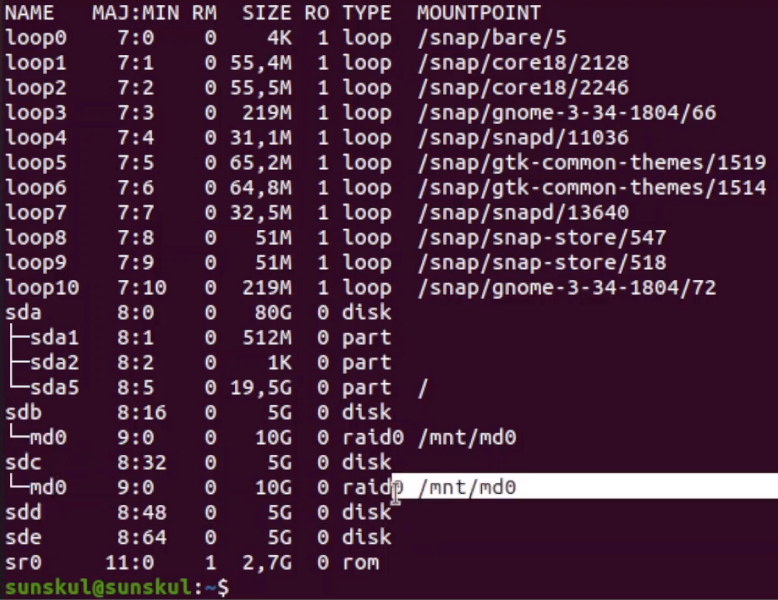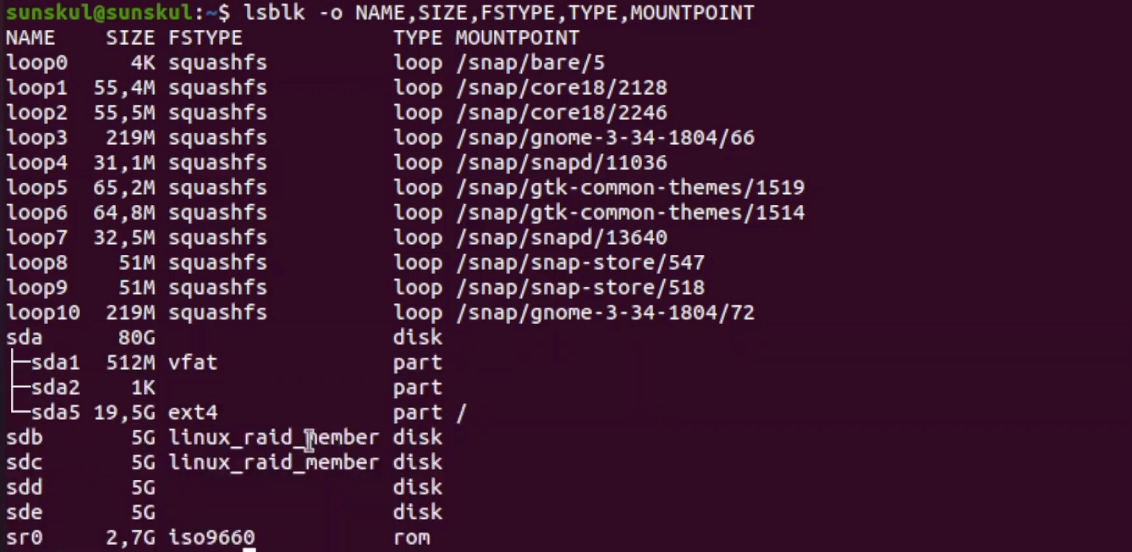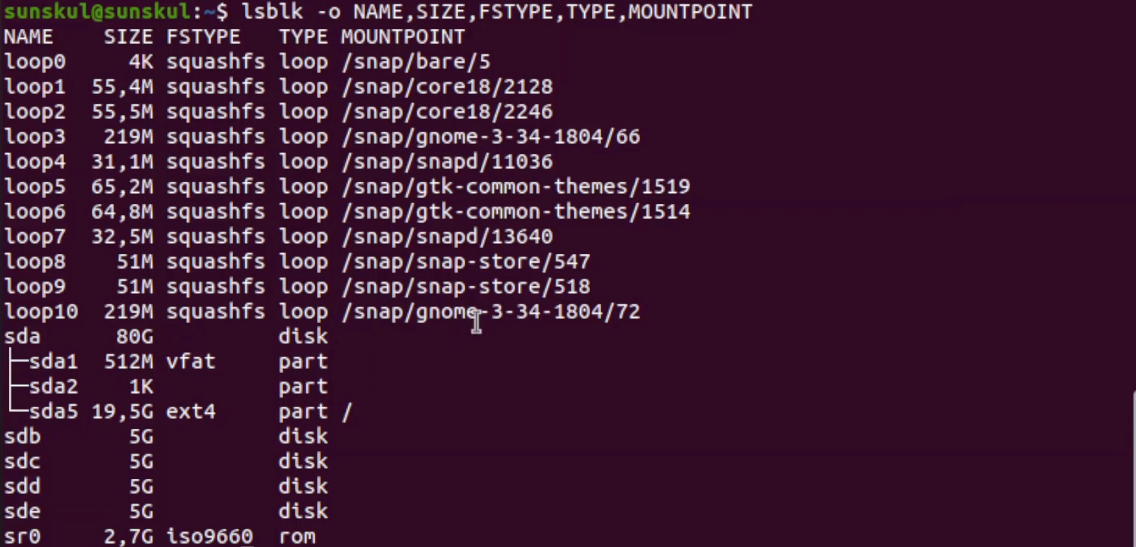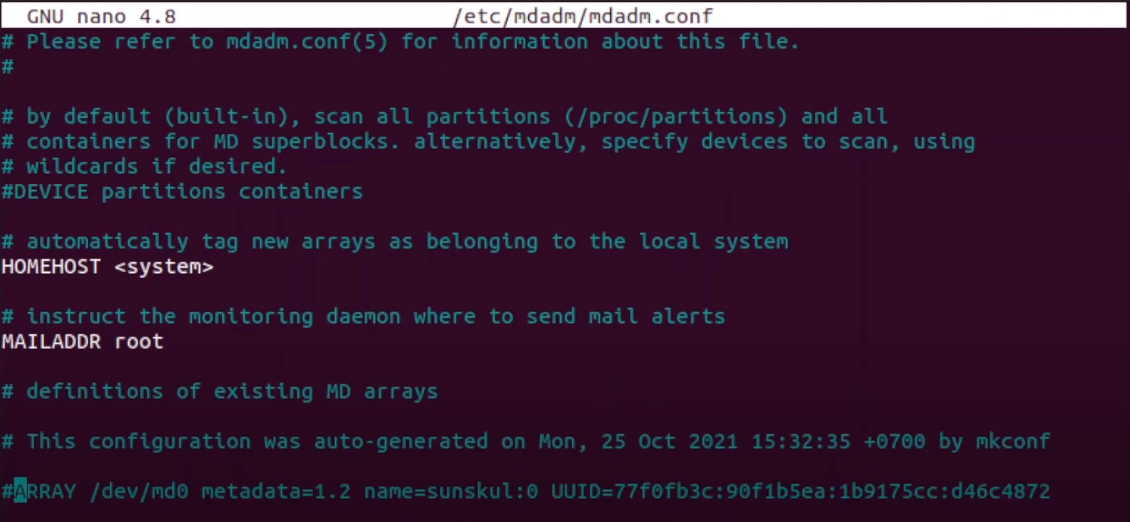Create And Manage RAID Array On Ubuntu 20.04
RAID Array
RAID devices are virtual devices created from two or more real block devices. This allows multiple devices (typically disk drives or partitions thereof) to be combined into a single device to hold (for example) a single filesystem. Some RAID levels include redundancy and so can survive some degree of device failure.. It will support user to improve performance and backup when using disks as virtual storage.
Linux supports LINEAR md devices, RAID0 (striping), RAID1 (mirroring), RAID4, RAID5, RAID6, RAID10, MULTIPATH, FAULTY, and CONTAINER. In this post, I will help you create and manage RAID array with 0, 1 and 5 on Ubuntu 20.04 (others are same)
Check RAID status and show the device infomation
Check RAID status
You can easily check with the following command:
cat /proc/mdstat

Show devices which were used to build or not build the RAID array
Type the following command:
lsblk -o NAME,SIZE,FSTYPE,TYPE,MOUNTPOINT
Install mdadm
mdadm - manage MD devices aka Linux Software RAID. More info about RAID and mdadm
mdadm [mode] <raiddevice> [options] <component-devices>
Get the infomation of RAID on device
To get the infomation of RAID on your device, you can:
`sudo mdadm -E /dev/md0
Create RAID array
You can create a RAID array and custom some demand such as RAID level, amount of devices,…
I will use sdb and sdc device to create RAID 0:
sudo mdadm --create --verbose /dev/md0 --level=0 --raid-devices=2 /dev/sdb /dev/sdc

After create the RAID array, you need to create the filesystem and mount it into the folder
Create file system
Type the command:
sudo mkfs.ext4 -F /dev/md0

Create a mount point and mount into the folder
Use mkdir to create a mountpoint:
sudo mkdir -p /mnt/md0
And mount /dev/md0 into /mnt/md0:
sudo mount /dev/md0 /mnt/md0
Save and config a automatic reassemble and mount RAID array
I was create a RAID array, and I wanna that the RAID array will be automatic reassembled at boot:
sudo mdadm --detail --scan | sudo tee -a /etc/mdadm/mdadm.conf

Next, I need that it will be automatic mounted:
echo '/dev/md0 /mnt/md0 ext4 defaults,nofail,discard 0 0' | sudo tee -a /etc/fstab

Finally, we need to update init ram file system:
sudo update-initramfs -u
If you do right, you will see the output which is used when you type lsblk command:

If you want to know how I create the RAID 1, 5, you can watch the video which I attached it on the top of page ^^
Manage RAID array/auto-mount
Now, I will manage RAID array with add, remove and reset a RAID array
Reset a RAID array
Before you reset a RAID, you had to umount it:
sudo umount /dev/md0
Next, let’s use mdadm to stop and remove it:
sudo mdadm --stop /dev/md0
sudo mdadm --remove /dev/md0

Now, the /dev/md0 is stopped and removed from RAID array. We try to check it:

As you can see that, it’s not yet clear. So we can use --zero-superblock to full reset:
sudo mdadm --zero-superblock /dev/sdb
sudo mdadm --zero-superblock /dev/sdc
Done:

Next, you need to edit the mdadm config file and fstable file because you were config it to automatic reassemble and mount before:
sudo nano /etc/fstab
The nano will appear and you need to comment or earase the ARRAY info:

sudo nano /etc/mdadm/mdadm.conf
Comment or earase the FSTAB info:

And let’s update the init ram fs now to finish ^^
sudo update-initramfs -u
Add a devide into RAID array
I will add a device on RAID 5. Note that the RAID 5 have at least 3 devices. I will add the sde device to the RAID 5:
sudo mdadm /dev/md0 --add /dev/sde
After that, we need to comment with # in mdadd.conf file as same as resetting step:
sudo nano /etc/mdadm/mdadm.conf
Append new RAID info into the file to mdadm reassemble array:
sudo mdadm --detail --brief /dev/md0 | sudo tee -a /etc/mdadm/mdadm.conf
Now the RAID have 4 active devices but only have 3 working devices. You need to grow up the RAID with:
sudo mdadm --grow /dev/md0 --raid-devices=4 --add /dev/sde
And resize the filesystem:
sudo resize2fs /dev/md0

Remove a devide from RAID array
Before you remove a devices from RAID array, you must to fail it first with:
sudo mdadm /dev/md0 --fail /dev/sde
Next, let’s remove it:
sudo mdadm /dev/md0 --remove /dev/sdc
After you remove the device, you need to re-edit the fstab file and mdadm file as same as previous part. Now, you were remove the devices succesfully ^^
Good luck <3
Note and reference
- This is a post which is wrote to share the way to create and manage RAID array.
- Special thank for linux.die.net and Digital Ocean Community.
- If you like my post, let you give me a star in Github and a like/follow in the youtube video 😄. Thanks a lot ❤️